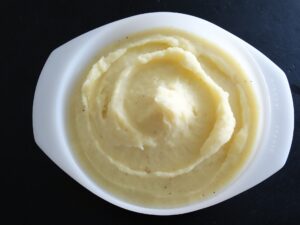
Getting the right consistency for your pasta sauce can be the difference between a magical, hearty meal and well, just a watery soup wanna-be. In this article, we’re discussing how to thicken spaghetti sauce and providing a full guide on all the ways you can get the job done.
Using Cornstarch

Cornstarch, or any starch for that matter, is made up of a long chain of glucose units that plants use to store energy.
When heated, cornstarch gelatinizes as it soaks up excess water around it. All you have to do is add cornstarch powder to the sauce.
Flour is a common ingredient that many people add to their sauces to make them thicker. But that’s not a preferred method because all-purpose flour can affect the taste and texture of the sauce, turning it dull and gritty.
Cornstarch, on the other hand, has a very faint or neutral flavor and it’s much easier to stir it into a sauce. Unlike a roux (more on this in a few minutes), you don’t have to combine cornstarch with anything to use it as a thickener.
In this method, you’ll use cornstarch plain and simple; in powder form. Just add a little bit of cornstarch to your sauce, stir it in, then let it simmer for about a minute until it thickens. Be careful not to add too much cornstarch to avoid ruining the texture of your pasta sauce.
Add Cornstarch Slurry
While it’s quite easy to use cornstarch powder as is, it can be an issue for many people because they fail to dissolve it completely. This is where cornstarch slurry comes in handy, consisting of equal parts of cornstarch and water.
Here’s what you’ll need:
- 1 teaspoon of cornstarch
- 1 teaspoon of water
- A bowl
- A spoon, whisk, or fork
Here are the steps:
- Make a slurry using the ratio of cornstarch and water mentioned above (you can make more slurry us
ing equal parts of the two ingredients but add 1 teaspoon at a time). - Stir the slurry into your sauce while it’s simmering.
- If the sauce is still not thick enough, add more slurry and stir it in.
- Once your sauce becomes the right consistency, remove it from the heat.
Here’s what you should keep in mind:
- Pour the slurry into the sauce gradually. Adding too much at once can turn the sauce too thick.
How to Thicken Spaghetti Sauce Without Cornstarch
If you don’t have cornstarch on hand or you simply don’t want to use it, you can thicken your spaghetti sauce using nothing at all. This method is called reducing and it requires only time.
Reducing the sauce is basically leaving it to simmer so that the excess water in it evaporates. It’s an efficient way that preserves the initial flavor of the sauce, and the only tools you need are a saucepan and a spoon.
Here are the steps:
- Pour the sauce into the saucepan or pot and place it on the stove.
- Bring the sauce to a boil then lower the heat just enough to keep it simmering.
- Stir the sauce from time to time until it becomes as thick as you prefer.
Here’s what you should keep in mind:
- The duration of simmering will vary according to the amount of excess water you want to remove.
- Leave the pan or pot uncovered to help the water evaporate more quickly.
- Be sure to keep an eye on the sauce to avoid burning.
With Pasta Water

At first, it sounds counterintuitive because adding water is normally used to thin out sauces when they’re too thick. But not pasta water.
In fact, pasta water works as a thickening agent, so it’ll have the opposite effect.
As pasta boils, it releases a lot of its starch content into the surrounding water. Adding some of the water from cooked (or almost cooked) pasta to your spaghetti sauce will provide the needed starch for thickening it.
Here’s what you’ll need:
- A saucepan
- A pasta basket or a strainer
- A spoon
- A bowl
Here are the steps:
- Use a pasta basket or a strainer to extract the cooked pasta and put it in a separate bowl.
- Take a couple of teaspoons of pasta water and add them to your spaghetti sauce while it’s simmering.
- Stir the sauce until it reaches the right thickness.
Here’s what you should keep in mind:
- After adding the paster water, the sauce might be a bit watery at first. This is normal. You just need to keep stirring it and you’ll notice it gets thicker gradually.
With Roux
Using roux to thicken spaghetti sauce can be a bit challenging for beginners to master.
Although it can be time-consuming to make, roux is a powerful thickening agent that produces a nice texture, so you may want to give it a try.
Here’s what you’ll need:
- Butter
- Flour
- Whisk
- A large, shallow pan
Here are the steps:
- Over low heat, cook equal amounts of butter and flour. You can start with 1 cup of each.
- Once they start to simmer, gradually add the spaghetti sauce until you get a velvety texture.
- Cook the mixture for an extra 20 minutes to get rid of any “raw flour” flavor.
Here’s what you should keep in mind:
- If you burn your roux, you’ll have to throw it out and start over. Nothing you’d add can mask the taste of a burnt roux.
How to Thicken Spaghetti Sauce With Mashed Potatoes

Potatoes are loaded with starch so if you have potatoes available in your kitchen, boil some, peel, then mash them to get a paste. Use the mashed potatoes as a thickener to fix your runny Spaghetti sauce.
Here’s what you’ll need:
- 1 or 2 potatoes
- A saucepan
- A pot
- A spoon or a fork.
Here are the steps:
- Place 1 to 2 potatoes in a pot full of water and boil them until they become tender. You can test this with a fork.
- Take the potatoes out of the water and peel them. The skin should come right off.
- Using a spoon or a fork, mash the cooked potatoes in a bowl.
- Add the mashed potatoes to the sauce a little bit at a time.
- Stir the sauce until it reaches the thickness you prefer.
Here’s what you should keep in mind:
- It’s best to do the peeling after boiling your potatoes not before. This will make the task so much easier that you won’t even need a peeler. You’ll be able to take the skin off with your hands.
- You can add a small amount of milk or butter to the mashed potatoes if you want the sauce to be more creamy.
- This method is likely to change the flavor of the spaghetti sauce so you need to be a potato lover to fully enjoy it. Otherwise, it’ll just be a waste.
- This method can also work with other mashed vegetables such as celery roots, kabocha, cauliflower, or even mashed butternut squash.
With Cheese

Did you know that you can use grated or shredded cheese to make your spaghetti sauce thicker? I mean, you were going to sprinkle some cheese on top of your spaghetti anyway, so why not put it in the sauce too?
Here’s what you’ll need:
- A block of cheese
- A saucepan
- A spoon
- A grater
Here are the steps:
- Use a cheese grater to grate some cheese.
- Add the grated cheese directly to the simmering sauce.
- Stir the sauce until it reaches the thickness you prefer.
Here’s what you should keep in mind:
- You can choose any type of cheese you want, but remember that most cheeses are rich in sodium. Adding too much cheese can make your sauce too salty.
- Using soft or semi-soft cheese can save you more time because it’ll melt quickly on low heat.
- Cheese burns easily so make sure you keep the stove temperature low.
- This method is may change the flavor of the spaghetti sauce so you need to be a cheese lover to fully enjoy the added creaminess.
With Bread Crumbs
Since breadcrumbs are primarily made of flour, you can use them for thickening your pasta sauce.
You can either buy a can of breadcrumbs at a supermarket, or you can make your own at home to save some money. It’s very easy too; just toast a bunch of leftover bread slices then crumble them into fine crumbs.
Here’s what you’ll need:
- A cup of breadcrumbs
- A saucepan
- A spoon
Here are the steps:
- Toss the breadcrumbs into the saucepan while the sauce is simmering. Add 1 spoonful at a time.
- Stir the sauce until it reaches the thickness you prefer.
Here’s what you should keep in mind:
- If you prepare your own breadcrumbs, you don’t need to use all of them. Just add a little bit at a time then check the consistency. If the sauce isn’t thick enough, add more and repeat.
- The sauce might look not very appetizing due to the presence of breadcrumbs.
- Breadcrumbs won’t affect the flavor of the sauce much.
With Egg Yolk
This may be surprising, but adding an egg yolk to your spaghetti sauce can make it thicker. Egg yolks are usually used to thicken

cream sauces or salad dressings, but they can work well with pasta sauces too.
Here’s what you’ll need:
- 1 or 2 egg yolks
- Medium bowl
- A whisk
Here are the steps:
- In a mixing bowl, add 1/2 cup of hot pasta sauce and slowly whisk in one egg yolk.
- Whisk for a minute until you get a smooth mixture.
- Add the mixture to your spaghetti sauce while continuously whisking.
- Allow the sauce to simmer for a minute, but don’t let it boil.
Here’s what you should keep in mind:
- This method may alter how your spaghetti tastes, but it won’t affect its texture or appearance.
- Make sure you temper the egg yolk first then add the egg mixture to the rest of the sauce. If you add the yolk directly to the sauce, it’ll cook too quickly.
- When tempering, do it slowly to avoid cooking the egg yolk. Just add a little bit of hot spaghetti sauce at a time while stirring constantly.
With Tomato Sauce
As I mentioned earlier, spaghetti sauce is often tomato-based. This means it’s pretty much the same as a tomato paste since the main ingredient in both sauces is tomatoes.
So, adding tomato paste to your pasta sauce can be a great way to make it thicker without changing the flavor.
Here’s what you’ll need:
- 1 – 2 tablespoons of tomato paste
- A saucepan
- A spoon
Here are the steps:
- Add 1 tablespoon of tomato paste at a time to your sauce while it’s simmering over low heat.
- Stir the sauce until it reaches the thickness you prefer.
Here’s what you should keep in mind:
- You should add the tomato paste to the sauce at the beginning so that the spices in the sauce have time to season it. This will also help you know whether or not you need to add more spices.
Wrap Up
There you have it, a complete guide on how to thicken spaghetti sauce.
Remember, you can avoid the watery sauce from the start if you properly drain your tomatoes and pasta. These are the two most common reasons for ending up with runny sauce.
